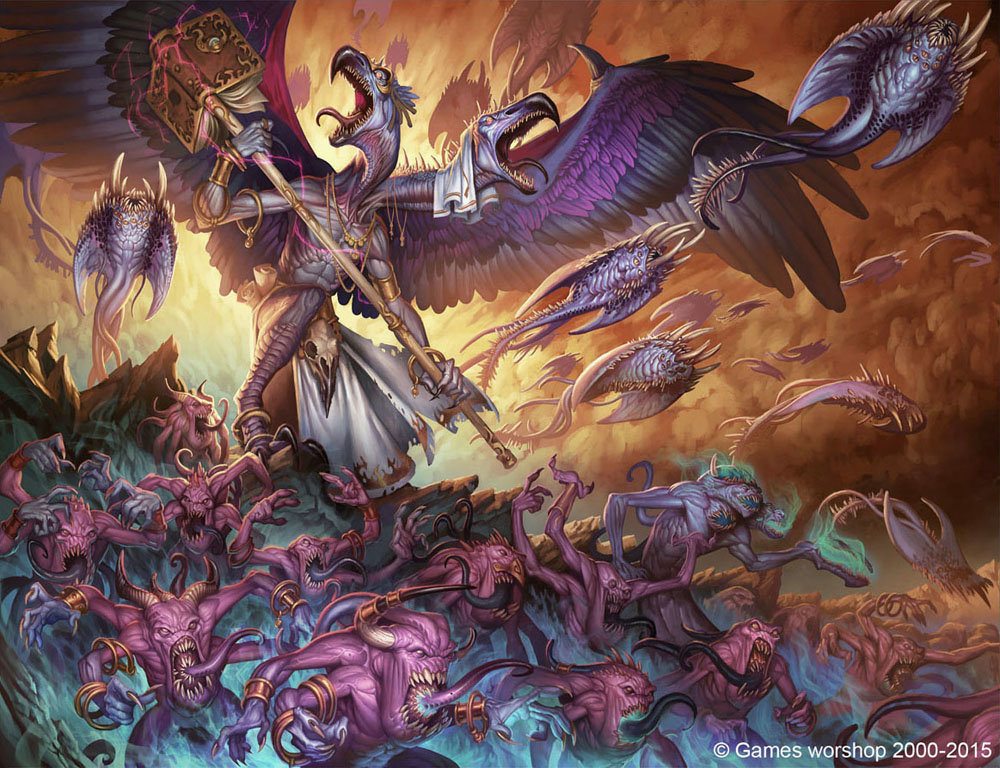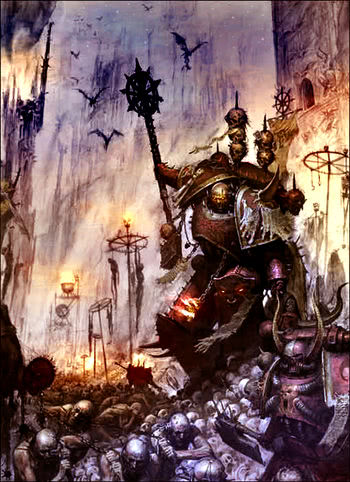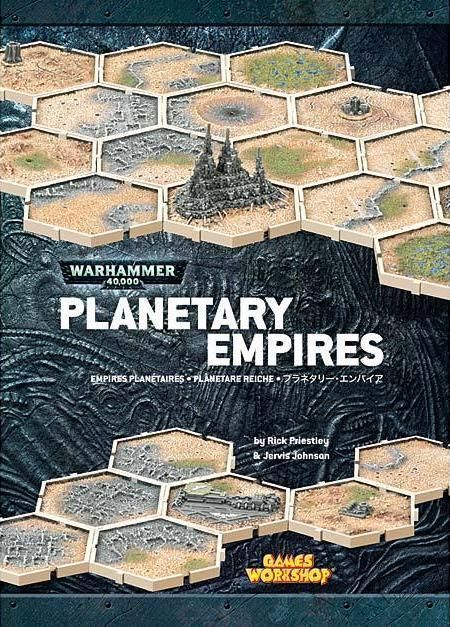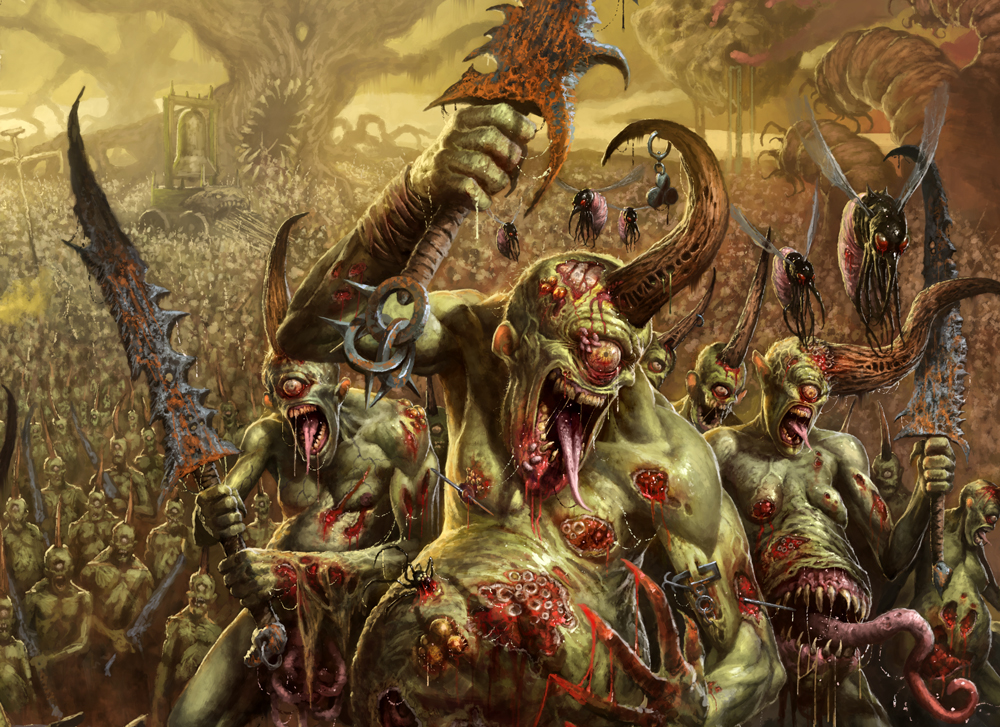Tyson C. brings us an editorial on the new summoning rules for Age of Sigmar 2nd edition.
Daemon summoning. Remember Daemon summoning? From 7th edition? Let me back up a bit.

I’m not much of a competitive player – my group of friends build their collections more or less based on the “rule of cool”. This isn’t to say that they don’t put up a fight, but none of us are really out to win a tournament. Some time in 7th edition 40k, I had picked the Word Bearers as the focus of a new army I was starting. I even convinced myself somehow that I was going to acquire the Dark Vengeance starter box and convert the entire Dark Angels half in to Word Bearers marines to save money. You know, because I’m a masochist.

Why the Word Bearers? I’m sure that the competitive 40k audience are immediately like “their legion trait is awful in 8th edition, why would you play them”. I’m not saying I disagree, but I’m sticking with them (rule of cool). No, I picked the Word Bearers because at the time, our small group of gamers needed a bad guy. Originally I was waffling between several different legions. That was before I started reading the Horus Heresy novels from Black Library. The Word Bearers jump-started the whole heresy. I usually gravitate towards the “good guy” in RPGs (video games and otherwise), and I figured it was time to branch out a bit. It seemed kind of weird to have these games where it was Imperium vs. Imperium, particularly since we were planning a map-based campaign, and I didn’t think it would be very fun for all of the Imperium players to gang up on the Tyranid guy (thematic, yes. Fun for the Tyranid guy — probably not).

I never really got to play much in 7th edition due to life moving a little too fast, so the insanity of Daemons summoning spiraling out of control didn’t really impact me. Let’s fast forward a bit to 8th edition. Boy, did the reveals for 8th edition generate a lot of excitement! I poured over the Index books excited to see what changes were in store and equally terrified that I might have to rebuild things to make them “game legal”. Hot on the heels of 8th edition and the index books was the Chaos Space Marines Codex!
Having acquired the Codex, I rabidly flipped through trying to understand what 8th edition meant for the Word Bearers. Now, I’m not typically one to get too worked up grumbling about things being “OP” or even “Underpowered”, but I have to say — the Word Bearers are fine, they’re just not very exciting rules-wise. Part of this lack of excitement has to do with having to pay reinforcement points for Daemon summoning (their legion trait is just kind of boring). Let’s be clear, Daemon summoning is METAL. How better do you establish yourself as the “bad guy” than by summoning warp entities who thrive on human emotion and feed on souls? For me, not getting to play very much made this even more of a pickle. How do I plan my points to include wiggle room for the limited number of daemon models in my collection while risking all of the characters capable of summoning them getting murdered before I can get them on the table? I still haven’t played much of 8th edition (I can probably summarize the “why” here by explaining that I’m a Dad now), but I did summon a big block of Bloodletters in one game and it was…okay. I just remember spending the whole game waffling over when to summon them and whether or not having to stand still that turn to do so was going to be counterproductive, etc.

Hopefully this bit of backstory helps explain that I’m personally not qualified to say conclusively that paying reserve points for summoning daemons in 8th edition makes sense or that it “works”. All I can say is that a lot of players probably avoid it for some of the same reasons I have.
So why am I writing this? Age of Sigmar 2.0. Despite not playing AoS myself (not that I wouldn’t give it a spin; it’s more a way to stay focused), I read most of the AoS previews out of curiosity. So far we’ve seen multiple previews regarding changes to summoning in the forthcoming 2nd edition of Age of Sigmar. So far there have been a few reveals, most notably:
- No reserve points for summoning!
- Instead, summoning is achieved via a resource specific to each faction
- Slaanesh – wounds caused that do not slay the target generate a resource
- Seraphon – completing rituals generates a resource
- Undead – more info coming
These are just a few examples, and I’m sure the reveals are going to include more and more. It’s also very obviously reminiscent of 7th editions latecomer “Khorne Daemonkin” and their concept of the “Blood Tithe”, which could be used for (among other things) summoning free daemons.
What do you think about the new AoS summoning rules?
And remember, Frontline Gaming sells gaming products at a discount, every day in their webcart!




Sounds very exciting that the resource dépends on the chaos god. In my more or less 20 games in 8th against chaos I have yet to see a player summon…
That kind of love would be great for summoning !
I always really loved the way the Blood Tithe worked, and the Slaanesh system in AoS2.0 seems like a really nice counterpoint to it. Seems like those sorts of mechanics would be much more fun than Reserves Points.
I agree! It adds another element to the game. You might be more or less liable to take risks to accumulate summoning points that you wouldn’t have otherwise taken.
As a Death player it is exciting to see the mechanic become relevant again. I am just hoping that it does not go overboard and create a situation where the summoning Haves are on a different and higher competitive plane than the summoning Have Nots by default. It will be very exciting if GW found the right balance for this mechanic though.
Balance would be key, yes. Particularly if one faction is perceived as being much easier to accumulate the summoning currency for. I would personally still leave some form of “summoning via reserve points” intact as an alternative.
The combination of the two would provide substantial flexibility.
‘free’ units and upgrades was a horrible aspect of 7th edition. While it’s neat in theory to cast a spell and get a pile of demons, or take a battle company and get better guns; it is not balanced in any sense of the word. 8th edition is a better edition and what helped make it so was eliminating free points. So the idea of getting free units is not a good one and even if they build in a new ‘cost’ system like AoS it’s just a crap shoot on if it’ll limit the free points enough to keep the game fair.
IMO, the intention of summoning in 40k was to give flexibility in your army by ‘building’ out unspent points mid-game, and allowing those new units to arrive on the board via deep strike when they normally couldn’t. Those benefits alone are pretty solid. You get surprise factor in your enemy doesn’t know what’s coming and has to factor in ‘unknown’ threats and advanced deployment options to boot. The restrictions though, is what made summoning lackluster. It requires characters, it’s a random roll, it can hurt you, it’s limited by chaos allegience, and your character must remain stationary the turn he does it.
From a competitive standpoint the juice just isn’t worth the squeeze. All those restrictions doesn’t justify the benefits that summoning provides. The deep strike benefit of summoning is now actually weaker as you could use a strategem to deep strike anywhere while summoning is restricted to 12″ from the summoner. Even forge world demon lords were setup with arch-demon summoning rules simply to give them that deep strike option. Now you can do it with a demon strategem and 2 command points and you aren’t restricted to 12″ from the summoner and the summoner won’t die in the process.
You want to fix summoning you need to remove the restrictions. Don’t require the summoner to be stationary as it’s a HUGE cost. Mobility is critical and removing mobility for summoning is not worth the effort when you factor in the need for aura abilities on the characters doing the summoning.
They could always give you demons that you need to summon at a discount. Like demons worked in 2nd. The fact you needed to summon them was (at least supposedly) considered in their cost.
The fact that they can’t fill in mandatory Detachment slots is also a significant drawback. Especially for the Troops Units that are often the most viable to Summon.
I 100% agree. Losing detachment bonuses and opsec rules on summons simply because they weren’t part of the detachment at the start of the game is just a stupid rule. If you allocate points to an army and then later use those points by a detachment to summon units, those units should be considered part of the detachment, even if they violate a FOC restriction like adding a 7th troop unit to a brigade with 6 troop units. Summoning needs to be a benefit, not a hindrance.
I agree with you about summoning not being worth it in matched play. If you’re paying reinforcement points for something, you want to know how it’s going to act. Preferably you’d want to know that it’s going to show up and what it’s going to be too!
As you said, summoning is better achieved by taking a detachment of daemons and spending the CPs to deep strike them in. And honestly, I think that’s a deliberate choice by GW. In matched play, when you want the fluff of Chaos Marines summoning daemonic allies, you can do it with some certainty. The Daemonic Ritual mechanic, however, is probably meant to be a narrative-play-only mechanic. It doesn’t make any sense in the context of matched play, but in narrative, where you don’t have to pay the points or PL for them and you probably don’t mind the random aspects of it, it’s actually a pretty cool, fun and fluffy mechanic.
Summoning is not functional now in matched play, but the argument is it SHOULD be. It has the potential to be very thematic and useful. The surprise factor alone could really affect the meta of tourney play. If I have 700 points of reinforcements and 3 characters that are in position to summon, my opponent has no idea what to prepare for. They could be flamers to cook all his obsec infantry or skull cannons to hits his back lines. If he turtles up in a corner I could drop a couple great unclean ones or scabbiathrax the demon lord right next to his castled units and they are trapped. You can also utilize non-standard units or units your opponent may not know very well. It has a ton of tactical application. Just need to lift some of the restrictions so it’s viable in a competitive setting.
Yeah, I can see that argument. I guess the surprise factor and the flexibility you get with summoning could maybe off-set the fact that it’s unreliable and restricted in terms of marks and limited to characters. Being able to summon exactly the right unit at the right moment, as you pointed out, is a huge advantage, especially in a tournament setting where everyone else kind of has to guess what the “meta” of the event is going to throw at them. Having the tactical flexibility of choosing what you want at a particular point is a massive advantage.
I like that they cost reinforcement points in matched play, though; free anything is bad IMO (see 7th ed). You should never be in a position where one player has a 2k army and the other has 2.5k.
I’m going to hit a complete tangent…. You mention in a photo caption using the Planetary Empire tiles in your campaign and it was ‘really cool’. I’ve got a couple sets of them and have been trying to figure out a ‘cool’ way to use them. I would be interested in hearing how your group used them for your campaign.
Thanks for the article!
This campaign took place in 7th edition, but we used the suggestions in the booklet with the planetary empires tiles. We had 4 participants in the campaign and the thing that struck me the most was that we all decided to plant our flags at the beginning based on what army background we had rather than necessarily what was the most effective.
When you have an element representing territory, it seems like there’s just more at stake when you win or lose a game.
I decided to claim populated areas and space ports as the Word Bearers because I reasoned it would be a good place for my cult uprisings to take root. The Tyranids started out in the jungle to accumulate biomass before assaulting the more populated areas. Decisions like this just made the campaign more interesting. Sadly, lots of real life changes occurred for the players and we never got to finish it.